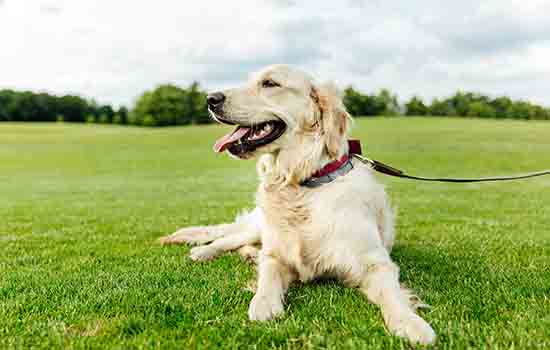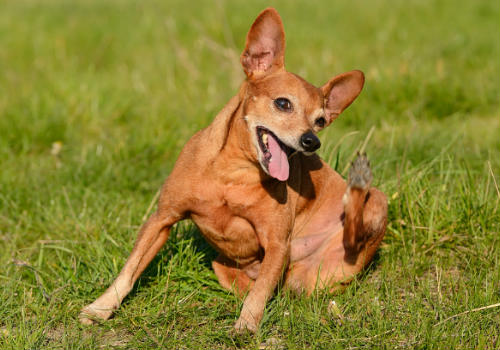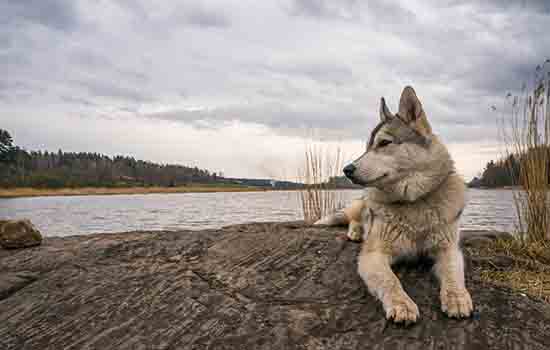You and your dog are curled up together on the couch, relaxing after a long day of work and play. Suddenly you see something out of the corner of your eye, and you feel a little twinge on your arm. You look down and your fears are confirmed: your dog has fleas and they’ve decided to join your cuddle session.
It’s a scenario that’s all too common among owners of all types of pets, but especially dogs. At some point during your adventures together, your dog happened to come across a flea colony and the opportunistic little pests decided to hitch a ride to your house. Before you know it they’re everywhere, leaving itchy bites on everyone in your home and breeding like, well, fleas!
Most people don’t know much about fleas other than that they’re tiny, they’re annoying and they can’t get enough of dogs. But what exactly are they, why do they end up on your dog and how do you get rid of them? Let’s learn more about these pesky parasites and find out the best ways to prevent and eliminate them.
Profile of a Parasite: All About Fleas
Fleas at a Glance

There are around 2,500 species of fleas found all over the world. All of them are small, flightless and bloodsucking, and they all use other animals, particularly mammals and birds, as their homes and food sources. Typically, though, one species, in particular, infests dogs and other pets: Ctenocephalides felis, the cat flea.
Other common flea species include the dog flea (Ctenocephalides canis) and the rabbit flea (Spilopsyllus cuniculi). As you can see, fleas tend to be named after their favorite hosts, but they’re not particularly picky and will take whatever food comes their way. At any given time, a dog may be home to one or more flea species, each reveling in the opportunity to feed and breed on your pup.
The Life and Times of Fleas
A flea goes through four distinct stages over the course of its little life. This is advantageous for the flea, which can make use of different survival tactics depending on its form, but troublesome for anyone trying to eliminate an infestation, as fleas may not be vulnerable to certain treatments if they’re not in the appropriate life phase. The four stages are egg, larva, pupa, and adult.
Egg Stage
All fleas start out as tiny white eggs, laid in batches of 10 to 50 at a time depending on species and environment. Adult fleas will lay eggs on their host animal, but the eggs aren’t naturally adhesive, so they’re likely to fall off unless laid in very dense fur. You can see flea eggs with the naked eye, but they’re less than half a millimeter long and easy to mistake for dust or debris, so you’ll have to look carefully to spot them.
Whether they end up on the floor, in your dog’s bed or on your dog, the flea eggs will usually hatch between two and seven days after being laid. If temperatures are low and the air is dry, it may take two or three weeks for the eggs to hatch. The baby fleas have stiff prongs on their heads called chitin teeth that they use to puncture the tough eggshell and begin the next stage of their lives: the larval stage.
Larval Stage
A newly-hatched flea looks nothing like the adult fleas we’re all familiar with. Rather, it resembles a small worm or caterpillar, starting out white and becoming brown or yellow as it feeds and ages.
The larval stage of a flea’s life is actually more like three stages in one. Over the course of the next one to three weeks, the larva will molt twice, taking on a total of three different forms before moving on to the next stage. With each molt the larva leaves behind its old skin or “casting” and becomes larger, starting out at about 1.5mm and growing to a maximum size of 6mm.
Flea larvae can move, but not very well: they don’t have legs, just rows of hairs, one on each of its 13 body segments. They tend to stick close to their hatching sites, where they’re usually able to find plenty of food. Their preferred food is droppings made mostly of dry blood, also known as “flea dirt,” left behind by adult fleas, though in a pinch they’ll eat any other organic matter they come across.
Though they lack eyes, flea larvae don’t like light or strong heat, preferring to stay in dark areas where humidity is above 70% and temperatures range from 70 to 90 degrees Fahrenheit. Amazingly, flea larvae use vibrations to detect their surroundings. They play dead when they pick up the vibrations of an approaching animal and, if they happen to be on your dog, will detect the vibrations of a scratching paw and wrap themselves tightly around a strand of hair to avoid falling off.
Pupal Stage

Once its third larval stage comes to a close, the flea begins to prepare for its biggest transformation yet. It gathers materials like lint, hair, fur and debris and binds them together with a special silk fiber it produces. Before long, it’s encased itself in a watertight, lightproof cocoon that’s virtually indistinguishable from typical household detritus in order to begin the pupal stage.
Over the next seven to ten days, the larva transforms from a legless, sightless worm into a high-jumping, super-sensory six-legged flea. It’s a similar process to the more widely-known butterfly pupation, during which the body completely disassembles and reassembles itself into an entirely different form while safely tucked inside the cocoon.
However, the flea doesn’t necessarily emerge as soon as the transformation is complete. It knows that as soon as it leaves its cocoon, it will need to find a host and begin to eat. If it doesn’t find a good source of blood within a week, it will die, so it remains dormant in the cocoon for up to a year until it detects the arrival of a host.
The vibration detecting abilities of the larval stage persist through the pupal stage, helping the flea to sense movement that indicates a potential host’s proximity. Flea pupae can also detect changes in carbon dioxide, which is exhaled by host animals, and warmth, which emanates from a host’s body. When these senses are triggered, the flea awakens and emerges from the cocoon in its adult form.
Adult Stage
This is the longest stage of a flea’s life and the one that we’re most familiar with. As soon as it emerges from the cocoon, the flea uses its powerful new legs to jump onto its chosen host and dig-in to its first-ever meal of fresh blood. Fleas begin to breed as soon as they encounter each other, and within two days after its first blood meal, a female flea will lay her first batch of eggs, beginning the cycle anew.
Life for an adult flea doesn’t stop there, though. It still has one to seven months of life left in it, during which it will continue breeding, feeding and biting. On average, adult fleas with hosts survive for around two months after leaving their cocoons.
Not every bite results in a meal; often, the flea will bite, decide the area is unsuitable for a meal, and continue its search. Flea saliva contains a desensitizing agent that numbs the area long enough for the flea to feed without being detected. Once the flea has moved on, the numbing agent wears off and the bite begins to itch.
As mentioned before, each species of flea has its own preferred host animal, but most fleas prefer animals with high body temperatures and dense hair or fur. Unable to regulate their own body temperatures, they rely on the warmth of their hosts to stay alive, and they enjoy the protection and added insulation that a thick coat of fur provides. This is why fleas may be happy to jump on you and bite you, but after their meal they’ll return to your dog – humans just aren’t hairy enough to make the fleas feel protected.
The Health Hazards of Fleas
It’s annoying to have fleas jumping everywhere, and the bites they leave turn into bothersome little bumps that may itch for a day or two. But many dogs have more severe reactions to flea bites, ranging from prolonged itching to bacterial infections to anemia.
Flea bite allergies are so common that they’re often not even thought of as allergies but as typical reactions to flea bites. Dogs with flea bite allergies will scratch and itch at the bites constantly, even biting them if they’re within reach of its mouth. This can cause pain, inflammation, and, if the skin is broken, open wounds that may bleed or become infected.
Various bacterial infections can be transmitted by fleas, including the serious Bartonella infection. Affecting cats and humans as well as dogs, Bartonella infection is also known as cat scratch fever and causes fever, cough, vomiting, diarrhea, inflammation of eyes and nose, lameness and swollen lymph nodes. If it occurs in immunocompromised dogs or is left untreated, Bartonella can damage the liver, spleen, heart, and brain.
As if fleas weren’t parasitic enough on their own, they can cause your dog to become infected with tapeworms if swallowed. Tapeworms live in the GI tract and leech nutrients from your dog, resulting in malnutrition, lethargy, weakness, vomiting, and diarrhea. If your dog has fleas, watch for these symptoms and check its stool and/or vomit for pieces of tapeworms; they look like grains of sand.
If the flea infestation is bad enough, your dog can become anemic from excessive blood loss. Puppies, senior dogs, and dogs with poor immune systems are especially prone to flea-related anemia, which displays as lethargy, low body temperature, weakness and paleness of gums and skin. Anemia requires urgent treatment including IV fluids and potentially a blood transfusion, so if you notice these symptoms take your dog to a vet right away.
Foiling the Fleas: How to Control and Prevent Flea Infestations
Environmental Concerns

Unfortunately, it’s highly unlikely that you and your dog will be able to avoid encountering fleas altogether. They’re simply everywhere: they hitch rides into your yard on squirrels and other small mammals, sneak into your house on mice and rats, jump from dog to dog at the vet or the park and even make short journeys on your clothes and body. If you or your dog ever encounter other animals or people, chances are you’ll cross paths with fleas at some point.
However, there are things you can do to make your home a less hospitable place for these unwelcome guests. Mow your lawn regularly and keep food and garbage safely secured to discourage flea-carrying critters from hanging out in your yard. Indoors, keep things tidy and dust-free to minimize hiding spots for larvae and pupae, vacuum all floors and upholstery once a week, wash-bedding often and don’t allow people with their own flea infestations into your home.
Preventative Products
Once you’ve tidied up, you can take further measures to prevent fleas from infesting your home and your dog. Over-the-counter and prescription flea and tick preventatives are highly recommended for dogs. They come in both oral and topical forms with various strengths and ingredients; consult your vet to determine the best choice for you and your dog based on breed, location, and lifestyle.
Many commercial pest-deterring sprays control fleas in addition to other bugs. These products are usually sprayed around the perimeter of the house, creating an impenetrable barrier that prevents fleas from entering your home.
For a natural option, try sprinkling food-grade diatomaceous earth around the edges of your house instead.
This can be found at many hardware, farm supply, and pet stores and consists of tiny shards of fossils whose sharp edges can’t be felt by large animals but can slice through fleas and their eggs. It can also be brushed into rugs and upholstery to prevent fleas from surviving on these surfaces.
Controlling an Existing Infestation
Preventing a flea infestation is always preferable to getting an existing one under control, but it can still be done, especially in the earlier stages of an infestation.
Medicated flea shampoo can help kill fleas on your dog; look for one that works on flea eggs in addition to larvae and adults. Some owners use diatomaceous earth on their dogs in addition to around the house, combing it gently into their fur to kill any fleas that walk across it.
You’ll need to maintain a treatment regimen diligently for weeks or months after the initial treatment to ensure that any fleas that hatch in the meantime are also killed. All it takes is a few stragglers to start the infestation up again, so don’t get complacent. Once the fleas are totally wiped out, make sure to keep up with your preventative measures to keep them away for good.

i never knew there was so much to know about fleas, a scary article that makes me want to get my dog checked. thank you for this info.
this doesn’t say WHY fleas choose dogs.